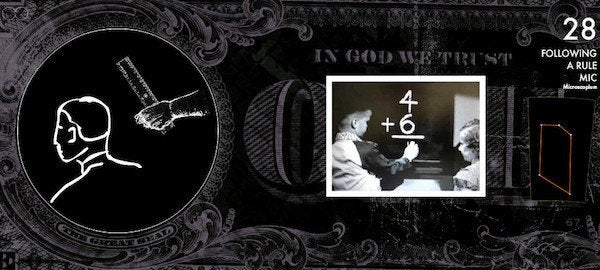
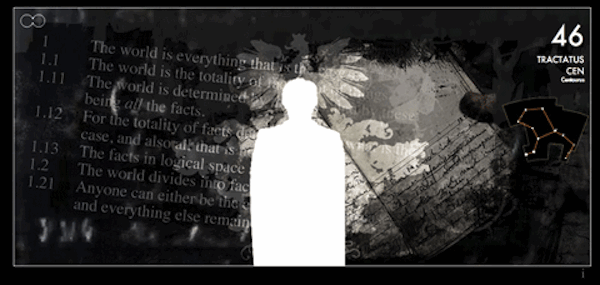 Still from David Clark's "88 Constellations for Wittgenstein"
Still from David Clark's "88 Constellations for Wittgenstein"
This is the third in a series on born-digital literature
David Clark's interactive website 88 Constellations for Wittgenstein combines animation, sound, text and voice-over narration to tell the story of one of the most important philosophers of the 20th century. Readers access the work by opening stars displayed on a black night sky. By clicking on named stars, for example, "Alan Turing," "LOL" or "ornament and crime," the reader accesses a wide range of stories about history, philosophy, popular culture, science and art history. "Connect the dots," the narrator advises. The story of Wittgenstein is constructed conceptually in the reader's own mind much as a constellation would be.
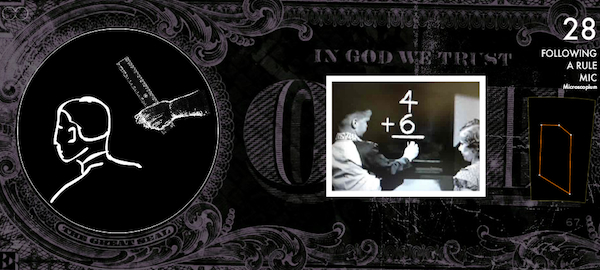 Screen Shot from "88 Constellations"
Screen Shot from "88 Constellations"
Wittgenstein calls language a game. For him, meaning is not inherent to language; rather it is acquired through use. The rules of the game are called grammar. If we want to communicate effectively, we will play by them, if we don't, the result is either nonsense or poetry. By organizing his narrative in the form of constellations, Clark overlays a sense of structure onto what would otherwise appear to be a chaotic collection of data. The result is a lyrical, thought-provoking, yet accessible work of art.
Clark's work illustrates two key characteristics of e-lit: It incorporates multiple medias to tell a story, and, by combining language with other media in unexpected ways, it reveals, expands and reconfigures the "natural" habitat of literature, thus opening up the possibility of new forms.
Media ecologist Neil Postman writes, "An environment is, after all, a complex message system which imposes on human beings certain ways of thinking, feeling and behaving. It structures what we can see and say and, therefore, do. It assigns roles to us and insists on our playing them. It specifies what we are permitted to do and what we are not."
There is nothing "natural" about a book or a text. Our expectations merely reflect the fact that we have internalized the rules so much that they appear to us as just the way things are. But, what happens when text or spoken word is introduced into an unexpected environment? What does a polar bear do in a jungle? It dies, or it adapts. Such is the case with e-lit, where there are more than a few examples of the former occurring and some exciting examples of the latter.
I asked David whether he conceived of 88 Constellations, included in the Second Electronic Literature Collection, as a form of literature.
I didn't think of 88 Constellations as just literature, but I do think there is literature in it. It evolved out of my background in the visual arts and cinema but it is more centered on the text than other kinds of work I do. I've never been a big fan of having to read text on the screen because it often means you can't look at the images. The use of voiceover means I can play around with the juxtaposition of the text and the image and the sound. It becomes a kind of mental counterpoint to read the images and hear the text and sometimes you can short-circuit the meaning in interesting ways. An example would be the odd connection between the minimalist architect Alfred Loos and the events of 2001 which I connect visually by flipping 'LOOS' to make it look like '2001.'Is this literature? I guess I'm interested in the work being in a conversation with literature because I think literature comes with some very sophisticated ways of approaching a work like this and hopefully brings the audience to the work with a sense of patience and expectation that I like. I think the Internet is a perfect place to invite that kind of in-depth engagement.
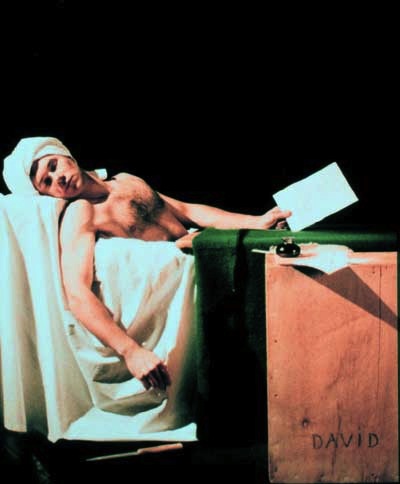 Still from Clark's filmBroken Crowns
Still from Clark's filmBroken Crowns
Illya Szilak: In watching your films, I am struck by your use of media codes. For instance, in Meanwhile, you don't try to keep dialogue or acting "realistic." As with artists Keren Cytter and Omer Fast's work, we become aware of the artifice of the process, and our ability to "read" cinema and our expectations for it. Can you comment on that?
David Clark: Yes, I agree. I think my approach to drama is to try to reveal the artifice while also using the familiarity of cinematic conventions to pull the audience in. I've approached this differently in different works. In my early work Broken Crowns I wanted the actors to be like nursery rhyme characters, you don't get a lot of back story or character arcs with Jack and Jill. They are just figures who serve the allegorical function of the story.
Could you relate this to Wittgenstein's ideas about language?
Well I certainly think there's a lot to say about that idea in the context of Wittgenstein's idea of language games. What Wittgenstein was trying to do was find out how any idea or concept was actually created from a particular use of language or a language game. I think of cinema as a kind of language game and I am playing with the rules, stretching them and finding out what assumptions we make when we look at cinema.
How did you move into film and net-based work?
I did a MFA in Sculpture where I was using sculpture at the time to extend my collage sensibilities. I was interested in combining things and using found objects in the work but I was also interested in using systems and stories. The move into film and video work kind of came out of doing some kinetic sculptures in grad school that I called "The Goldberg Variations" where I used found objects to create a kind of working Rube Goldberg device. From there I moved to the idea of making narrative films where the narrative was built like a conceptual Rube Goldberg that emphasized how we got from event to event. I tried to adapt cinematic conventions but I found the linearity of film limiting. I always seemed to be making clusters of meaning that could be unfolded in different ways. I like the idea of browsing as a narrative experience. I call this 'narrative vertigo,' which I think of as a kind of conspiracy theory feeling, where meaning seems to loom up out of what seemed like discrete and unrelated facts. This is what Wittgenstein talks about as "aspect of seeing"; that is the meaning of something... like that famous duck/rabbit illusion... has to do with how we look at it not what it actually is.
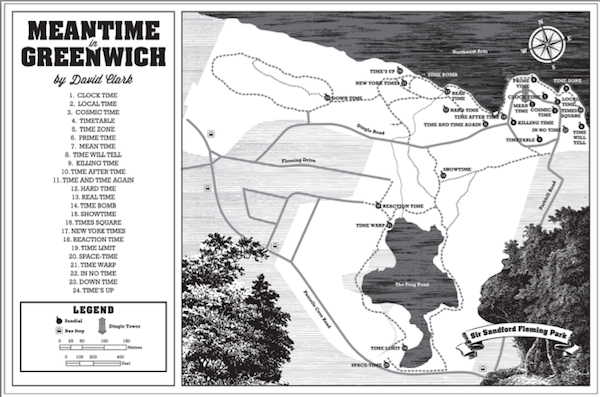 Map for Clark's interactive Installation "Meantime in Greenwich"
Map for Clark's interactive Installation "Meantime in Greenwich"
Your newer pieces are public art installations. Can you talk about embodied interactivity versus virtual interactivity -- is this something you think about?
I do think about this. The embodied and the virtual are two sides of my practice; the sculptural and the screen-based. I have been working on the screen for such a long time and now I'm pushing back into real space -- into the sculptural -- but I'm taking the web-like narratives of the Internet work with me. It's a funny moment for media artists because mobile computing allows the audience to be both in the virtual space of the screen while also having an embodied experience in the real world.
In the public art pieces I am really trying to make them accessible to the public. In a way I think the net has mainstreamed the avant-garde traditions of art making. The net is a danger free zone for non-art audiences to explore new weird forms. Public space is still a kind of funny place for people to encounter new experiences. With my public art pieces I use a kind of Trojan Horse strategy: I sneak the art into something that seems familiar and non-threatening like a vending machine or sundial in a park, something that seems to fit its surroundings. Then I can play with the surprise of discovering something unexpected in something familiar. The challenge with the stories is to enhance the embodied experience. In the piece Meantime in Greenwich, that I made this summer in a park in Halifax, the viewer hears 24 stories on their cell phone triggered by GPS and can see 24 virtual 3D objects using an augmented reality browser. The piece involves 24 sundials that act as the triggers for the virtual experiences in the park. The stories all center on Sandford Fleming, the father of Standard Time and the piece is installed in the Sir Sandford Fleming Park where Fleming lived and died. So the embodied experience also triggers the virtual dimension of the history of this particular place that maybe the public doesn't know about.
